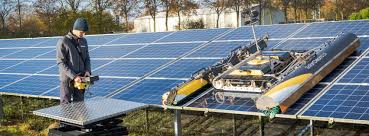Revolutionizing Solar: How Robots Are Shaping the Future of Solar Panel Installations

In the world of large-scale solar installations, every detail counts. From the heavy lifting of modules to navigating remote locations, the challenges can seem insurmountable. But what if there was a solution that could drastically reduce labor demands, improve safety, and accelerate installation timelines? Enter robotics.
The spark for this breakthrough idea came during a visit to a solar manufacturing facility near Detroit. Watching robotic arms efficiently move solar modules along the assembly line, David Lincoln, Senior Vice President of Rosendin Electric had an epiphany.
“Why not apply this to the field?' We could use robots to speed up the installation process and make it safer for workers," he recalls.
That moment led to a simple sketch on a napkin—an idea that would soon revolutionize the solar industry.
The Concept: Robots for the Toughest Tasks
Large solar projects span acres of land, with modules weighing up to 100 pounds each. With extreme temperatures and humidity, the physical toll on workers is immense.
"It’s back-breaking work. Moving and positioning these heavy panels multiple times a day is dangerous," Lincoln said. The vision was clear: adapt mini-excavators with robotic arms and suction cups to automate the process of lifting and placing solar panels.

The team embarked on an 18-month journey to develop the idea. Their breakthrough came when they found a robotic arm prototype used for manhole operations in Long Island. It wasn’t a perfect match, but it had potential.
"We didn’t have an exact solution at first," Lincoln said, "But we knew it could be modified."
After countless design iterations and testing, they created a semi-autonomous, three-piece robotic unit.
"The first reactions were skeptical. People questioned if it would work," Lincoln explains.
But as the robots proved their worth in the field, the team saw how their creation could change the game.
These robots have had a transformative impact on the installation process. "We can install modules up to three times faster than traditional methods, even running at reduced speeds for safety," says the project manager. These robots not only speed up installation but significantly reduce risks of back injuries and strains by handling the heavy lifting.
They’ve also helped tackle weather challenges. By creating "micro lay-down yards" and covering modules in place, the robots protect equipment from harsh elements, ensuring safety and durability until installation.
A Collaborative Workforce: Robots and Humans Working Together
One of the biggest concerns surrounding robotics is job displacement. However, workers have embraced the robots.
Instead of replacing jobs, the robots help workers focus on more specialized tasks. Field workers have even suggested adding features like a string wire dispenser or ground-penetrating radar, showing a high level of engagement with the technology.
"The robots take over repetitive tasks, allowing workers to be more efficient and reduce fatigue," Lincoln adds. "It’s all about collaboration."
The robots are already improving project timelines and cutting costs. Time-motion studies show that robots can install panels up to three times faster than manual labor, resulting in faster project completion and reduced labor needs. The hybrid power system, which uses both electric and diesel, allows them to run for up to 20 hours a day, ideal for remote locations.
The team at Rosendin plans to scale the technology, with hopes of partnering with major manufacturers.
"We see a future where these robots are mass-produced and available to contractors across the industry,” Lincoln said. "And solar is just the beginning—we’re already exploring applications in other sectors like data centers and infrastructure."
The construction industry has traditionally been resistant to change, but the success of these robots is breaking down barriers.
"Once people see the benefits—speed, safety, and cost savings—the transition becomes much easier," Lincoln said.
The team believes education and communication will help accelerate wider adoption.
On April 17, 2025, Rosendin will host a demonstration day in Abilene, Texas, showcasing the robots in action.
"We’re excited to give industry professionals a first-hand look at how these robots are changing the game," Lincoln said.
Developers and business leaders across the renewable, manufacturing, construction, technology, and private equity sectors are encouraged to join the demonstration and discover a variety of business opportunities.
As solar projects expand, robotics will become a cornerstone of the industry’s future. These robots are not just tools—they're a testament to the power of innovation in solving real-world challenges.
"By enhancing safety, speeding up installations, and reducing costs, we're setting the stage for a new era of efficiency in solar energy," Lincoln concluded.
The future of solar installation is here, and it's robotic.
The smartest construction companies in the industry already get their news from us.
If you want to be on the winning team, you need to know what they know.
Our library of marketing materials is tailored to help construction firms like yours. Use it to benchmark your performance, identify opportunities, stay up-to-date on trends, and make strategic business decisions.
Join Our Community






